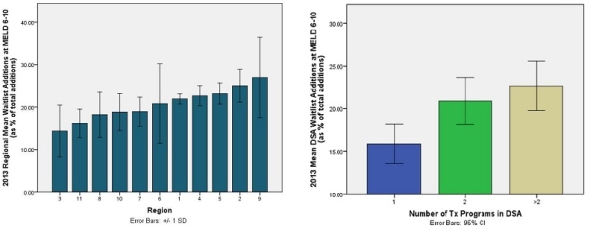Geographic Variation in Listing Practices Represents Competetive Behaviors and Access to Care Rather Than Differences in Demand for Liver Transplantation
1University of Kansas Medical Center, Kansas City, KS
2University of Pennsylvania, Philadelphia, PA.
Meeting: 2015 American Transplant Congress
Abstract number: 486
Keywords: Allocation, Liver transplantation, Public policy, Waiting lists
Session Information
Session Name: Concurrent Session: Liver Transplant Allocation Policy
Session Type: Concurrent Session
Date: Tuesday, May 5, 2015
Session Time: 4:00pm-5:30pm
 Presentation Time: 4:48pm-5:00pm
Presentation Time: 4:48pm-5:00pm
Location: Room 122-AB
Purpose: This study evaluates whether program and patient demographics influence liver transplant listing practices.
Methods:
2013 liver waiting list and transplant (Tx) variables, US Census socioeconomic variables, CDC end-stage liver disease (ESLD) mortality data, and healthcare access data (Dartmouth Atlas) were pooled to the DSA level and analyzed for bivariate correlations; multivariate analysis of variance/covariance (MANOVA/MANCOVA) models were used to assess the categories of MELD at listing.
Results:
Waiting list mortality rate (WL-MR) and Tx rate are positively correlated (Pearson's r=0.732, p<0.001) while WL-MR and Tx rate are negatively correlated with % of low MELD (6-10) wait list additions (r=-0.415, p=0.002 and r=-0.531, p=0.001, respectively). MANOVA indicates significant regional variation in MELD category at listing with 32.7% of the variation among the DSAs accounted for by region (p=0.003). When the number of physicians per 100,000 residents is included as a covariate, the model accounts for 54.4% (p<0.001) of the variability in percentage of low MELD (6-10) listings with 20.5% attributable to no. physicians/100k (p=0.003) and 36.8% to region (p=0.033). A second MANOVA model with post-hoc analysis indicates that DSAs with 1 Tx program list a significantly lower percentage of patients at low MELD score than those >2 programs (p<0.001). 42.1% (p<0.001) of the variability in ESLD mortality rate among the 51 DSAs is accounted for in a linear regression model containing the following predictors: uninsurance rate (p<0.001), acute care hospital beds per 1,000 residents (p=0.037), and college education (p=0.002). ESLD mortality rate was not associated with percentage of low MELD listings.

Conclusions:
In the existing 11 region system, the density of physicians and number Tx programs/DSA influences center listing practices. Competition among Tx centers likely underlies this behavior. Whether redistricting might alter competitive behavior and change listing practices warrants due consideration.
To cite this abstract in AMA style:
Voss J, Gilroy R, Goldberg D, Schmitt T, Kumer S. Geographic Variation in Listing Practices Represents Competetive Behaviors and Access to Care Rather Than Differences in Demand for Liver Transplantation [abstract]. Am J Transplant. 2015; 15 (suppl 3). https://atcmeetingabstracts.com/abstract/geographic-variation-in-listing-practices-represents-competetive-behaviors-and-access-to-care-rather-than-differences-in-demand-for-liver-transplantation/. Accessed July 12, 2025.« Back to 2015 American Transplant Congress
